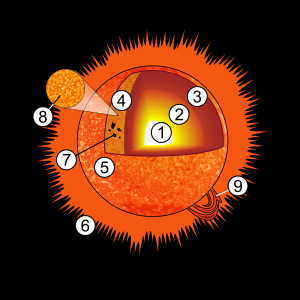The Sun is one of the numerous stars present in our Universe. The Sun is a hot ball of gas and fire. It is the only star visible during the day time. It is a very huge ball of fire. The mean distance of the Sun from the Earth is approximately 149.6 million kilometers (1 AU), though the distance varies as the Earth moves from perihelion in January to aphelion in July. At this average distance, light travels from the Sun to Earth in about 8 minutes and 19 seconds.
The Sun orbits the center of the Milky Way at a distance of approximately 26,000 light years. The Sun is formally designated as a Yellow dwarf though from the surface of the Earth it may appear yellow because of atmospheric scattering of blue light.
- The Sun is about 1.99 x 1030 Kg in weight and accounts about 98.8556% of the mass of the Solar System.
- The mean radius of the Sun is about 6.96 x 105km .
- Its mean density is 1410 Kg/m3
- Its acceleration due to gravity at the surface is 274 m/s2
- Its surface temperature reaches upto 6000 K and thus is an orange star.
- Its rate of emission of total radiation is 3.92 x 1026 Watt
- Its escape velocity is 617.723 Km/sec
- It takes 37 days at the poles and 26 days at the equator.
- It is about 93 million miles! away from the earth(93 million miles = i astronomical unit(AU)).
- Its mean distance from the center of the Milky Way galaxy is 26,000 light years.
- It orbits the center of the galaxy at a speed of 220 Km/s
 |
| Surya |
 |
| Helios |
Sun was once thought of a God. In different mythologies, Sun represented different Gods. In Greek Mythology, Sun was named as Helios. In Indian myths, it was called by different name like Surya, Bhaskara etc..
The Sun is mainly composed of Hydrogen and helium but traces of other elements are found in it.
- Hydrogen - 73.463%
- Helium - 24.851%
- Oxygen - 0.769%
- Carbon - 0.292%
- Iron - 0.157%
- Sulphur - 0.124%
- Neon - 0.122%
- Nitrogen - 0.09%
- Silicon - 0.07%
- Magnesium - 0.05%
- Core: The core is the innermost layer of the sun and it is a source for all the Sun's energy. The material in the core is firmly attached and has very high temperature, which is about 15 million degrees Kelvin. In the core the intense heat destroys the internal structure of an atom and therefore all atoms are broken down into their constituent parts. An atom is composed of protons, electrons and neutrons. Neutrons have no electric charge and so they do not interact a lot with the surrounding medium. Thus neutrons go away the core fairly and quickly. The protons, which have positive electric charge, and the electrons, which have negative electric charge, remain in the core and force the reactions which fuel the Sun. The charge neutral material of protons and electrons that makes up the core is called plasma. The high temperature provides the protons and electrons with a great amount of thermal energy and therefore they moved pretty quickly and they combine with the high density of the plasma, causes the particles to continuously slam into one another creating nuclear reactions. It is the fusion, or slamming together, of particular combinations of particles that provides the energy source of the Sun.The core is the innermost layer of the sun and it is a source for all the Sun's energy. Thermonuclear reactions takes place inside the core ,thus hydrogen atoms are comnbined with each other to make helium atoms and produces energy which keeps the Sun in a state of equilibrium.Thus this thermonuclear reaction is called nuclear fusion

- Radiation Zone: Once the energy is produced in the core of the sun, it has to travel from the solar center to the outer regions. Hence the radiation zone provides an efficient means of transferring energy near the core. The temperature in the radiation zone of the sun is cooler than the core. The material 0.2 to about 0.7 solar radii is hot and dense enough that thermal radiation is sufficient to transfer the intense heat of the core outward. Heat is transferred by ions of hydrogen and helium emitting photons, which travel a brief distance before being re-absorbed by other ions.
- Convection Zone: Ranging from 0.7 solar radii to 1.0 solar radii, the material in the Sun is not that much dense or hot to transfer the heat energy from interior to outward. Hence, thermal convection occurs as thermal columns carry hot material to the surface (photosphere) of the Sun. As soon as the material cools off at the surface, it plunges backside downward to the base of the convection zone, to obtain more heat from the top of the radiative zone. Convective exceed is thought to occur at the base of the convection zone, moving turbulent down flows into the outer layers of the radiative zone.The thermal columns in the convection zone shape mark on the surface of the Sun, in the form of the solar granulation and supergranulation. The turbulent convection of this outer part of the solar interior gives rise to a 'small-scale' dynamo that produces magnetic north and south poles all over the surface of the Sun.
- Photosphere: Photosphere is the visible surface of the Sun. Above the photosphere, sunlight is free to disseminate into space and its energy escapes the Sun completely. Sunlight has approximately a black-body spectrum that indicates its temperature is about 6,000 K, interspersed with atomic absorption lines from the tenuous layers above the photosphere. The photosphere has a element density of about 1023/m3 (this is about 1% of the particle density of Earth's atmosphere at sea level). The parts of the Sun above the photosphere are referred to collectively as the solar atmosphere. They can be seen with telescopes across the electromagnetic spectrum, from the visible light to gamma rays.
- Chromosphere: This a thin layer present above the visible surface, which is about 2,000 km thick, specifically dominated by a spectrum of emission and absorption lines. It is called the chromosphere from the Greek root chromos, meaning color, for the reason that the chromosphere is visible as a colored flash at the beginning and end of total eclipses of the Sun.
- Corona: The corona is the outer atmosphere of the Sun, which is much larger in volume than the Sun itself. The corona merges slickly with the solar wind so as to fill the solar system and heliosphere. The low corona, which is very close to the surface of the Sun, has a particle density of 1011/m3 (Earth's atmosphere near sea level has a particle density of about 2x1025/m3). The temperature of the corona is several million degrees K. The corona can be clearly seen during a total solar eclipse or during an annular solar eclipse when a ring is seen on the sun.
 |
| The Chromosphere |
The Sun was formed 4.57 billion years ago when hydrogen molecular cloud collapsed. The cloud came close by because of the pull of gravity and the cloud of gases started to heat up due to friction. The temperature became so hot that the hydrogen atoms started colliding with each other, Nuclear Fusion started taking place and thus the Sun was formed.
The Sun is already half-way through its main sequence of evolution. In another 5 billion years, the sun would have consumed all of the hydrogen present in it and it the main phase of it would start i.e becoming a Red Giant. Since it doesn't have enough mass to turn into a nova or a supernova, the Sun will settle down as a white dwarf but it would have consumed all of the planets in itself including the Earth.
The light which is emitted from the sun is the primary source of life on earth. The Sun emits about 1368Watt/m2 which is known as the Solar constant. The amount of light reaching the earth's surface is only 1000Watt/m2 . The rest is attenuated(absorbed) by the earth's atmosphere.









0 comments:
Post a Comment